I am a believer that chivalry isn’t, or should not be, dead. My wife tells me that when we were first dating, she was enamored with the fact that I held the car door open for her. Well, I also hold the door open for her when we enter or leave a restaurant and most any time the opportunity arises. However, I had a secret that my wife wasn’t aware of. I wasn’t just being chivalrous — my behavior was also for our mutual safety.
When approaching a doorway with my wife, if I step slightly ahead of her in order to open the door, it gives me an opportunity to scan the entryway or exit location. It allows me to see what’s ahead before we enter a restaurant or exit the mall doors. And if there’s something I don’t like or that threatens our safety, I have the opportunity to rapidly turn and get us out of there.
When we’re leaving somewhere, once we get in the parking lot and we’re getting into our SUV, going to her side to open her door allows me to get a good look into adjacent cars to ensure no one who might do us harm is sitting in them. It also lets me get a good look behind all four tires of my vehicle before I back out of the parking stall, ensuring there are no errant (or purposely placed) nails that will flatten my tires and cause me more headaches on the side of the road later.
Teamwork
Now my wife knows my secret and readily accepts the logic behind my chivalrous deeds. She is still enamored that I open doors for her. But now she also knows she plays a critical role in our safety plan and that we are stronger as a team during a critical incident than we would be if one of us did not know how to react or failed to react to the other’s input if we ran into a bad guy in a parking lot, mall, etc. We even talk about — and train for — that unlikely occurrence.
That’s not to say my wife and I train like Navy SEALs or that we are as efficient as the Secret Service when it comes to protecting one another. But as a couple, as a team, we both understand that if something were to happen, we both have roles to play.
Parking-Lot Scenario
These things don’t have to be overly complicated. One situation we discuss and train for is what we would do if we were walking through a parking lot and observe an individual who raises our suspicions and puts us in Condition Orange. While we would be a formidable force fighting together side by side, we’re also an easier target if we allow that individual to get close, say under the guise of asking a question, and then pull a weapon in an attempt to rob or kidnap us. Therefore, something as simple as splitting up while walking to the car prevents the bad guy from containing both of us within arms’ reach. It also allows us to divide and conquer should the person who approaches decide to draw a weapon. With each of us on opposite sides, the bad guy would have to divide his attention beyond his peripheral vision in order to be a viable threat to both of us, and either my wife or I would have the tactical advantage should he turn to look or engage the other.
Of course, my wife and I understand the basics of not getting caught in a crossfire situation. With practice, anyone can work through and understand the proper angles.
Vehicle-Based Scenario 1
The other situation my wife and I discuss is what to do if we are inside our vehicle and a threat approaches from outside. We practice two likely vehicle-based scenarios. The first is a threat that approaches our vehicle from the driver’s or passenger’s side. This scenario involves the driver immediately driving forward or backward, utilizing any available space between our vehicle and another vehicle to the front or rear, in order to rapidly gain valuable space between us and the threat. Then we discuss how we would engage the threat with either the driver or passenger engaging with a firearm or pepper spray, depending on the threat.
When engaging a threat that’s outside your vehicle, both people must understand that certain things must happen. You must maintain control of the vehicle in order not to cause others in the vicinity undue injury, and you must ensure that if you’re shooting cross-cockpit (so to speak), the other person stays out of the line of fire. Muzzle discipline is paramount in this scenario to ensure everyone in the vehicle stays safe. These two musts can be accomplished a variety of ways, from the passenger steering the vehicle while the driver engages the threat to maintain control of the vehicle, to the passenger slipping to the floorboard to stay out of the line of fire.
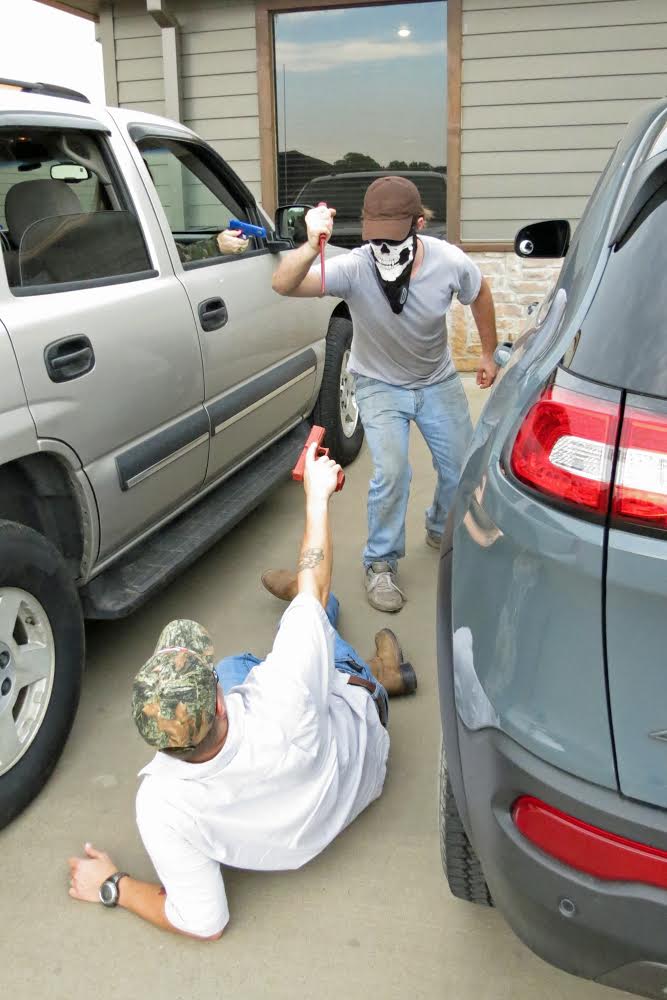
Dropping to the ground helps give the person inside the vehicle a clear field of fire at the threat. Photo: author
Vehicle-Based Scenario 2
The second vehicle-based scenario we discuss is what we would do if a threat were to engage one of us while the other is already inside the vehicle. After I assist my wife in getting into the passenger seat of our SUV and close and secure her door, what if someone approaches and attempts to rob, kidnap or otherwise hurt me?
This scenario means that the person inside the vehicle becomes the primary shooter, because the person outside it is either going to be defending a threat or unable to resist if caught unaware. Muzzle discipline is again paramount to ensure that only the bad guy gets shot. By discussing these scenarios, both husband and wife can have a preset plan on what to do. For example, the person outside the vehicle could drop to the ground, allowing the person inside to have a clear field of fire at the bad guy. If in a struggle, the person outside could attempt to turn the bad guy to allow a clear shot from the person inside the vehicle, and so on.
Active-Shooter Situation
The last scenario my wife and I discuss is what we would do if caught in an active-shooter situation. I rarely leave my wife’s side when we’re shopping at a grocery store or mall. But if we do separate, we make it a point to say not only where we’re going to in the store but also where we’ll meet back and a secondary location. This allows us to know where to look for the other person if we’re separated in a store or mall and something suddenly goes wrong. We can rapidly find each other at one of two designated areas in case one of the meeting points is compromised.
Of course, there are limits to our meeting if something goes wrong while we’re shopping. We both know that if the something that goes wrong is gunfire, we both immediately take the nearest exit out of the building, attempt contact via cell phone and, as safely as possible, move back to our vehicle to meet and depart the immediate danger area. This also means I’ve discussed with my wife that an “emergency exit” can be a door, window, loading dock, “employee only” entry/exit, or any portal that safely accesses the outside of wherever the shooting is taking place. There are no off-limits areas as long as it means a safe exit and does not involve getting someone into an enclosed, inescapable location.

When leaving a public parking space, check for nails or other objects that can cause a flat tire. Photo: author
Be Prepared
There are no definitive solutions in any of these scenarios. There are no guarantees that if you are outside your vehicle while your spouse is inside, and you’re suddenly approached by an armed robber, that he can safely be engaged from within the vehicle. The backstop, time, position, anything could affect the outcome of this or any of these scenarios.
However, one thing is certain. If you never discuss with your spouse the possibility of what could happen at the places you usually go and in the manner you usually travel, then if something does happen, he or she will be unprepared to respond in a pre-determined way. This forces a reaction, versus a response, that may not lead to a desired outcome for you both. This all takes practice and communication. It takes teamwork!
So remember, the next time you walk into a store, take the time to open the door for your spouse. Take the time to help her into the car the next time you’re in a parking lot. And when you do, take the time to look around and scan your surroundings. You’ll find she appreciates it and you’ll both be a little safer.
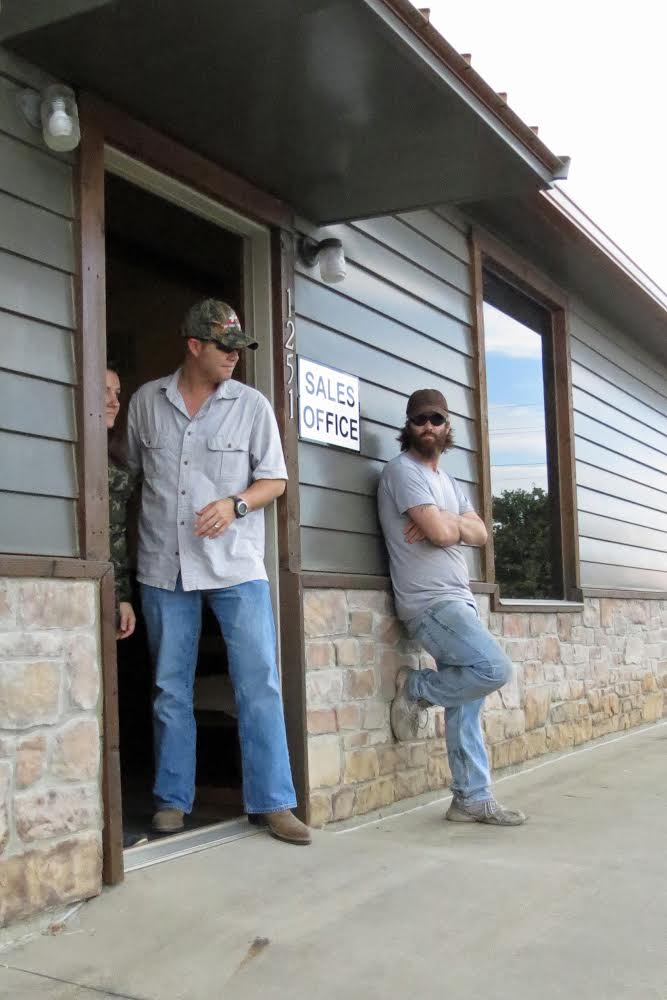
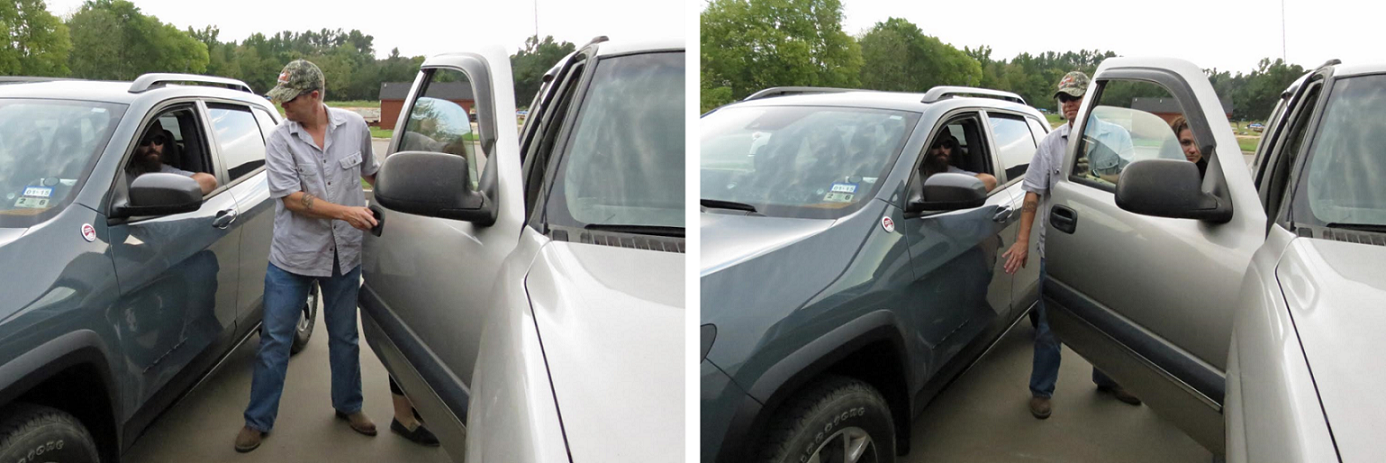
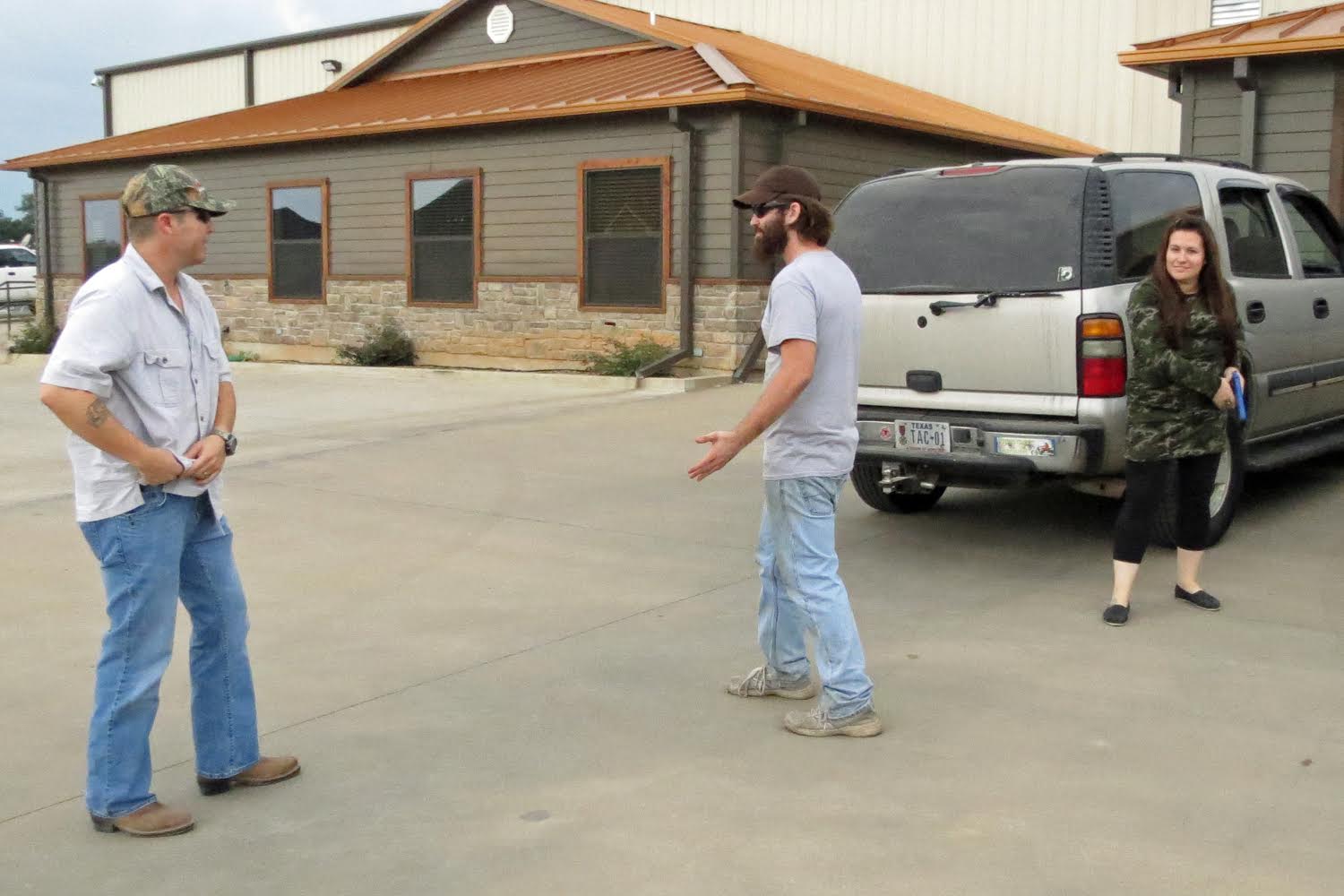
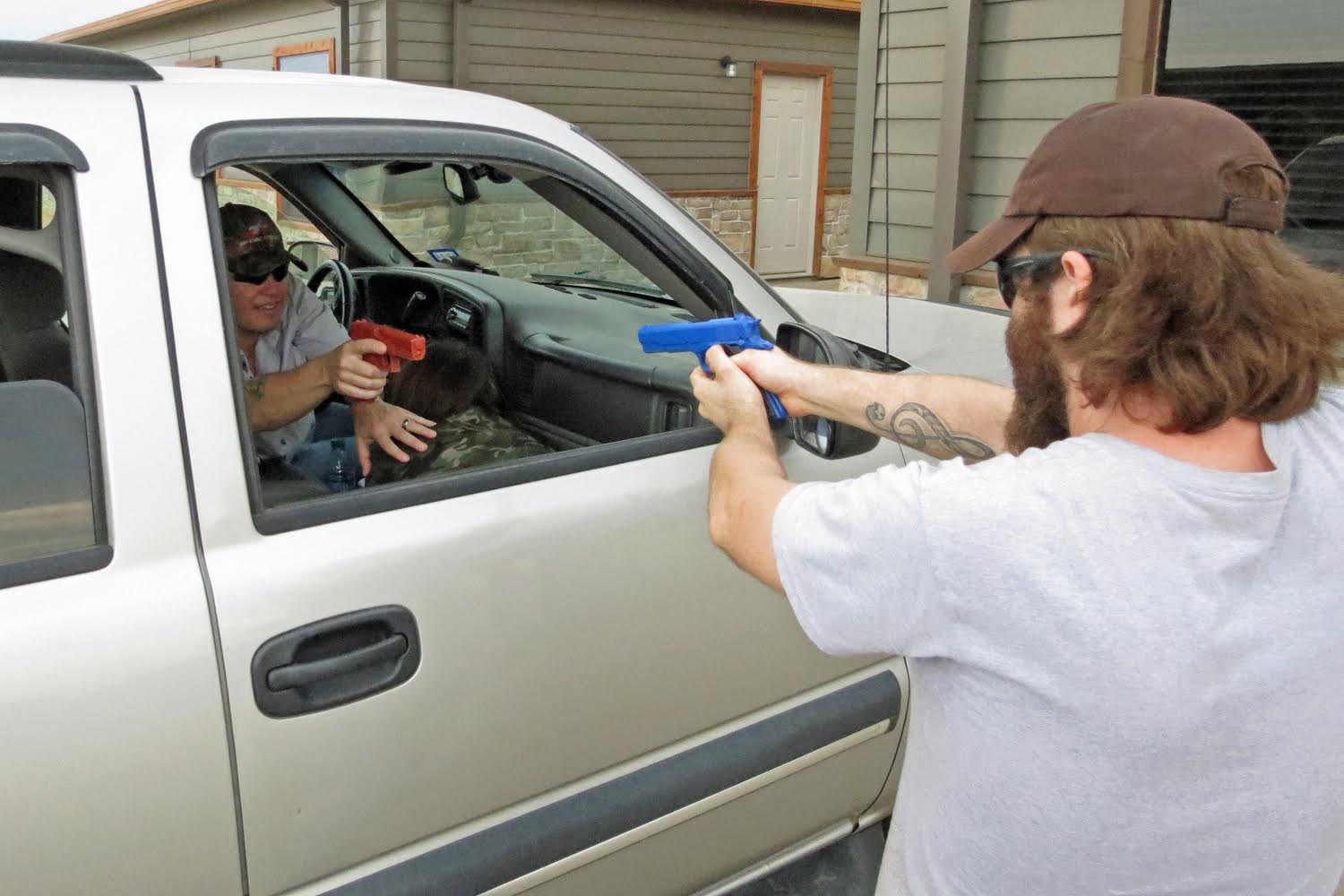
I have been opening doors (cars & buildings) for my wife for over 34 years. I never really thought about the defensive nature of doing so until reading this article. I must admit I do look into cars parked next to us and I am very aware of my surroundings. Now I have more to think about. Thanks Rob.
Like the teamwork aspect
These are good ideas for protection. Parking lots are becoming more dangerous each year in the US. I always scan the parking lot from a radius of at least 50 feet from my vehicle. If there are two or more suspicious people (men and women) then I wait until they move out of the way. If they were to head toward my vehicle and wait, then I would go back toward to store entrance and wait.
I always try to park right next to the shopping cart storage spot so there's one side of my vehicle that's not next to another car. Plus it's convenient when ditching the cart properly when we leave.
Interesting thought about splitting up in a parking lot. My wife and I practice getting off the "X" when we practice drawing and confronting approaching danger. Throws the possible threat off their game plan as they probably expect you to stand close together when confronted. We need to discuss if there are multiple people coming at you what we should do. but I think splitting up would again throw off their game plan. I worry about parking lots. Threats can come at you quickly while you are relatively alone. If you and your wife train to separate she also has to have a means of defense. At the minimum pepper spray. My wife is training now with her pistol. we both have had CCWs for a long time but I only recently started to carry most of the time. she is still getting used to carrying a loaded gun in concealment. Needs to build her confidence in herself and the weapon. she does carry pepper spray most of the time. your partner should be fully trained in some sort of defensive weapon of you are going to split up.
Great article very engaging thanks PDN
Never thought of using chivalry this way. Good points!
Fine article, Dan. About the Active Shooter response: I've seen other articles advocating Run, Hide, Fight in that order. Am I the only one who thinks one reason we carry is to help protect others? In an Active Shooter scenario, wouldn't it be a good thing, once you've secured your family's safety, to try to stop the shooter and prevent additional casualties? Sure, the cops will do that, but when?
I like the article
This happened in 1998, a man was walking toward my wife 8 months pregnant and I, getting ready to car jack us, when a group of people came out of the restaurant. He walked over to a fast food joint pulled his gun on 2 guys in there car. They slammed it in reverse and took off, so needless to say we were lucky. I carry now, but the wife won't touch a gun. Lesson learned: scan your surroundings, trust no one.